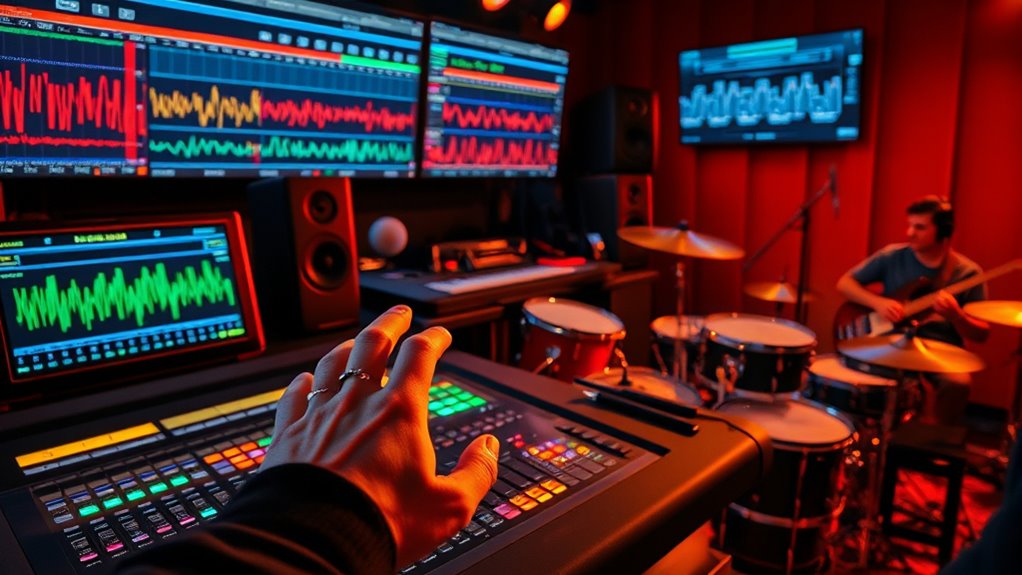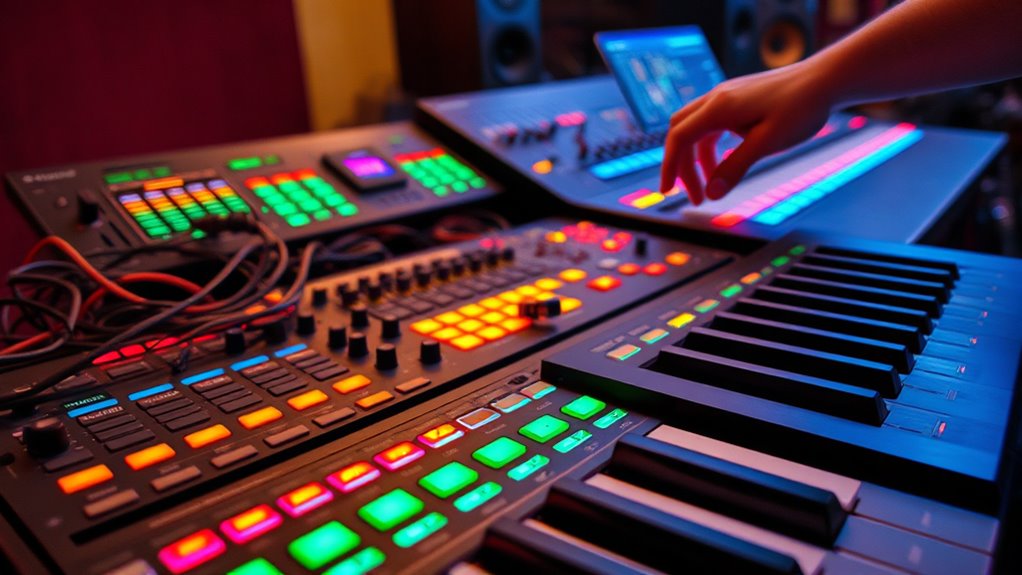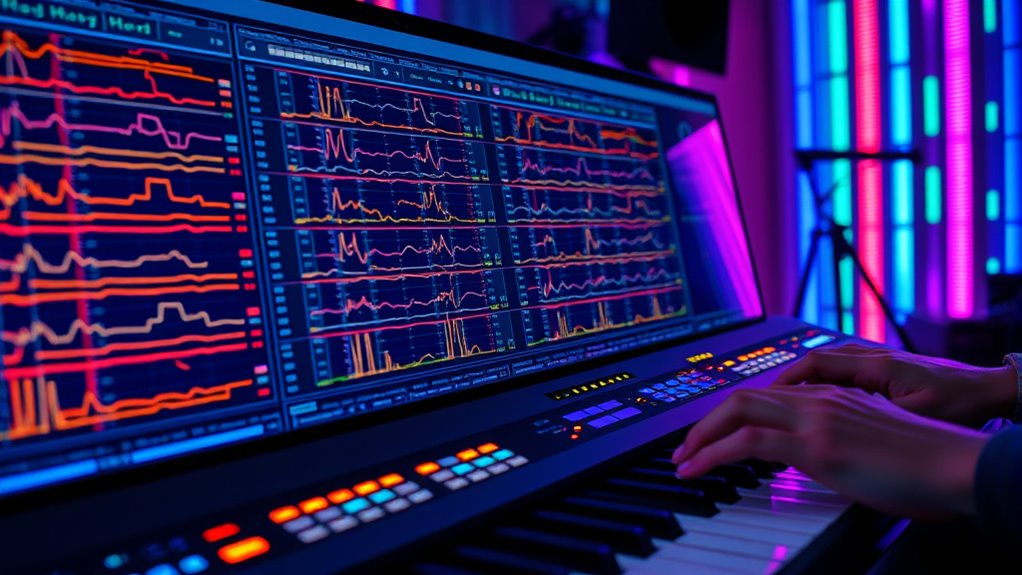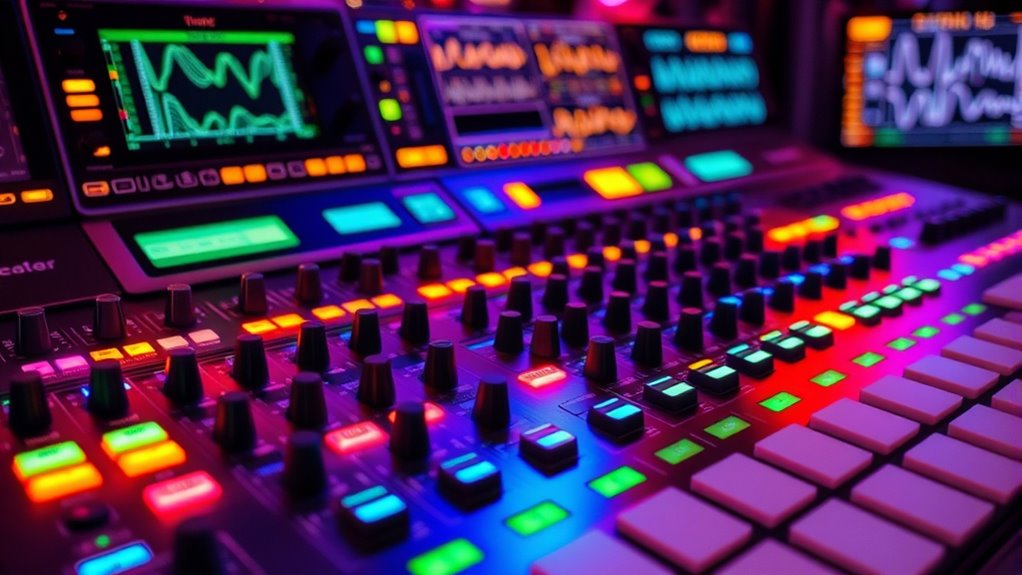To make complex polyrhythms danceable in pop, focus on layering contrasting rhythms like steady beats with syncopation or triplets. Use your DAW to program subtle variations and experiment with different time signatures to create tension and momentum. Keep grooves natural by applying humanization techniques and balancing rhythmic complexity with simplicity. mastering these techniques will help you release dynamic, engaging rhythms—continue exploring to discover more ways to craft compelling, danceable grooves.
Key Takeaways
- Layer contrasting rhythmic patterns, like steady quarter notes with triplets, to create engaging, danceable polyrhythms.
- Use subtle variations, accents, and humanization techniques to maintain groove while adding rhythmic complexity.
- Balance rhythmic tension by locking some patterns to the downbeat while offsetting others for dynamic flow.
- Utilize templates and preset patterns to streamline workflow and ensure rhythmic consistency across song sections.
- Focus on rhythmic layering and flow to develop tension, release, and movement that keep listeners engaged and dancing.
Understanding the Basics of Polyrhythms

Polyrhythms occur when two or more different rhythmic patterns are played simultaneously, creating a complex and engaging groove. As a producer, understanding this foundation helps you craft rhythms that feel both intricate and natural. Think of it as layering different rhythmic ideas that don’t necessarily align perfectly but complement each other. For example, one pattern might emphasize triplets while another sticks to straight eighth notes. The key is recognizing how these rhythms interact over the same span of time. By mastering the basics, you’ll see how polyrhythms add tension and release, making your music more dynamic. This understanding allows you to experiment confidently, knowing how to build rhythmic complexity without losing groove or listener engagement. Additionally, understanding the role of contrast ratios can help you balance the elements within your mix to enhance the overall rhythmic feel. Exploring different rhythmic interactions can further deepen your grasp of how to make polyrhythms feel natural and compelling within your productions. Incorporating percussive layering techniques can also help you achieve more nuanced and engaging rhythmic textures. Moreover, incorporating AI security principles into your workflow can help protect your creative assets from cyber threats, ensuring your ideas remain safe as you experiment with complex rhythms.
Identifying Common Polyrhythms in Popular Music

Many popular songs feature polyrhythms that subtly enhance their groove and complexity. You can recognize these by listening for overlapping rhythmic patterns that don’t align perfectly but create a sense of movement. For example, in Afrobeat or jazz-influenced pop tracks, you’ll often hear a 3 against 2 pattern—triplet phrases layered over duple beats. In hip-hop, you might notice a 4 over 3 feel, where a triplet-based rhythm interacts with a standard beat. These polyrhythms often underpin the groove without dominating the melody, adding depth. By actively listening for contrasting rhythmic groupings within the drum patterns, basslines, or melodic phrases, you’ll begin to identify these common polyrhythms that subtly shape the feel of many hits.
Techniques for Incorporating Polyrhythms Into Your Tracks

To effectively incorporate polyrhythms into your tracks, start by experimenting with layering contrasting rhythmic patterns within your drum and bass parts. Try placing a steady quarter-note pulse alongside a triplet-based rhythm or a duplet pattern against a triplet feel. This contrast creates a sense of tension and complexity that’s still groove-friendly. Use MIDI or drum machine programming to lock these patterns together, ensuring they interact intentionally. Subtle variations, like shifting accents or syncopation, can enhance the polyrhythmic texture without overwhelming the groove. Listen closely and adjust timing to maintain a natural flow. Remember, the goal is to make these rhythms feel integrated, so don’t hesitate to simplify or emphasize certain layers until the polyrhythm feels intuitive and danceable. Incorporating tuning techniques can help refine the rhythmic interplay and ensure your polyrhythms align seamlessly with your track’s harmonic structure. Additionally, understanding auditory processing can improve your ability to perceive and craft complex rhythmic relationships more effectively. Exploring rhythmic subdivision can also provide deeper insight into how different layers interact and contribute to the overall groove. Being aware of local supermarket hours can even inspire listening sessions during off-hours, when stores are less crowded, to analyze rhythm and flow in a real-world environment.
Creating Groove and Momentum With Rhythmic Layers

Creating groove and momentum with rhythmic layers hinges on how effectively you combine and emphasize different patterns to drive the track forward. Start by layering contrasting rhythms—such as a steady kick with syncopated percussion—to create a compelling push and pull. Use subtle variations in velocity and timing to add human feel and prevent the rhythm from sounding too mechanical. Focus on locking certain patterns to the downbeat while offsetting others to generate tension and release. Dynamic layering keeps listeners engaged and encourages movement. Remember, the goal is to craft a sense of flow; rhythmic complexity should enhance groove, not distract from it. Incorporating quality over quantity in your layering choices ensures each element contributes meaningfully to the overall feel. Paying attention to percussive placement can significantly enhance the groove and make the rhythmic landscape more engaging. Additionally, understanding how rhythmic layers interact can help you craft more compelling and danceable patterns. Being mindful of human feel can also prevent your patterns from sounding overly programmed, adding an organic touch. By thoughtfully stacking and emphasizing your layers, you create a rhythmic landscape that propels your track with energy and purpose.
Practical Tips for Programming Polyrhythms in Your DAW

To program effective polyrhythms, start by selecting rhythmic layers that complement each other and create interesting tension. Use quantization intentionally to preserve the groove while maintaining rhythmic complexity, and consider employing polyrhythm templates to speed up your workflow. These practical tips can help you craft compelling polyrhythms that enhance your pop productions. Additionally, understanding the retail hours of stores like Game Cameron Toll or Joanns Craft Store can be useful for planning sessions or sourcing supplies during off-peak times. Familiarity with precious metals investment options can also inform how you diversify your musical assets or manage licensing rights.
Selecting Rhythmic Layers
Choosing the right rhythmic layers is essential for crafting effective polyrhythms in your DAW. Start by identifying the core groove or feel you want to emphasize. Then, select layers that complement and contrast this foundation. For example, pair a steady kick pattern with a syncopated hi-hat rhythm to create complexity. Focus on rhythmic subdivisions—like dividing bars into different groupings—that add interest without overwhelming the listener. Avoid layering rhythms that clash or become too busy; instead, aim for balance and interplay. Experiment with different time signatures and note densities to see what enhances your track. Remember, the goal is to make the polyrhythm feel natural and danceable, not forced or overly complicated. Choose layers that serve your overall groove and keep the rhythm engaging.
Quantizing With Intention
Quantizing with intention is essential when programming polyrhythms, as it helps you maintain the groove’s complexity without losing its natural feel. Instead of blindly snapping everything to the grid, focus on subtle humanization. Here are three practical tips:
- Use *elastic quantize* or *groove templates* to preserve the groove’s swing and feel while tightening rhythmic accuracy.
- Quantize only specific layers or notes, leaving others slightly off-grid to retain a natural, organic vibe.
- Adjust the quantize strength slider to find a balance between timing precision and groove authenticity.
Applying these methods ensures your polyrhythms sound tight but lively, keeping the danceability intact without sacrificing musical complexity.
Using Polyrhythm Templates
Polyrhythm templates are powerful tools that can streamline your workflow and guarantee rhythmic consistency when programming complex patterns. They serve as starting points, helping you quickly experiment with different rhythmic combinations without reinventing the wheel each time. Many DAWs and MIDI plugins offer built-in templates or allow you to create custom ones. Once you load a template, you can tweak the rhythms to fit your song, saving time and maintaining precision. Using templates also encourages consistency across different sections of your track, making intricate polyrhythms feel more natural. With practice, templates become a springboard for creative exploration, empowering you to craft complex, danceable patterns efficiently. Additionally, AI Content Clusters can be employed to organize related rhythmic concepts and techniques, enhancing your workflow and creative options.
Examples of Polyrhythms in Contemporary Pop Hits

Have you ever noticed the complex rhythmic layers in hit songs like Drake’s “In My Feelings” or Beyoncé’s “Partition”? These tracks showcase polyrhythms that make the music feel both intricate and danceable. To understand how, consider these examples:
- “In My Feelings” features a triplet feel layered over a straight 4/4 beat, creating a syncopated groove that’s irresistible on the dance floor.
- “Partition” combines a 6/8 feel with a 4/4 rhythm, blending different subdivisions for an exotic, hypnotic effect.
- “Uptown Funk” uses polyrhythms between the drums and bassline, adding bounce and drive to its infectious groove.
- The use of automation technology in music production allows producers to craft complex rhythmic textures that engage listeners on multiple levels.
- Understanding regional variations in rhythm can help producers create more authentic and engaging pop tracks that resonate across diverse audiences.
- Incorporating knowledge of zodiac sign compatibility and cultural influences can inspire rhythmic patterns that evoke specific emotional responses or cultural authenticity in music.
Frequently Asked Questions
How Do Polyrhythms Influence Listener Emotion and Engagement?
You might wonder how complex rhythms affect your audience’s feelings and involvement. When you incorporate polyrhythms, you create a sense of surprise and intrigue, making the music feel more dynamic and emotionally engaging. These rhythms can evoke excitement, tension, or even a hypnotic state, encouraging listeners to connect more deeply with your music. By making rhythms danceable, you keep your audience captivated and enthusiastic to experience more.
Can Beginners Easily Incorporate Complex Polyrhythms Into Their Production?
You might wonder if beginners can easily incorporate complex polyrhythms into their production. It’s definitely possible, but it takes practice. Start by experimenting with simple polyrhythms, like 3 against 2, using your DAW’s grid or percussion tools. Break down the rhythm slowly, then layer it into your track. Over time, you’ll develop a feel for these patterns, making your music more dynamic and engaging.
What Are Common Pitfalls When Programming Polyrhythms in Digital Audio Workstations?
When programming polyrhythms, you might find yourself in deep water if you don’t pay attention. Common pitfalls include misaligning grid settings, which throws off the groove, or overcomplicating patterns, making them hard to follow. Also, neglecting to quantize or sync your parts can cause timing issues. To keep things smooth, double-check your tempo, use metronome, and stay consistent with your rhythm, so your complex ideas stay danceable.
How Do Cultural Differences Affect the Perception of Polyrhythms in Pop Music?
Cultural differences shape how you perceive polyrhythms, influencing their impact in pop music. If you’re used to African or Latin rhythms, you might find complex polyrhythms exciting and danceable. Conversely, Western listeners may prefer simpler, steady beats. As a producer, you should consider your audience’s cultural background to craft rhythms that resonate and feel natural, making your music more engaging across diverse listeners.
Are There Specific Genres Where Polyrhythms Are More Effective or Popular?
When you explore genres like Afrobeat, jazz, and progressive rock, you’ll find polyrhythms thrive, energize, and elevate the music. These styles embrace rhythmic complexity, making the dance floor vibrant and the listening experience immersive. By weaving multiple rhythms together, you create a rich tapestry that captures attention, invites movement, and deepens emotional connection. So, your best bet is to experiment where rhythm’s richness and complexity are celebrated and amplified.
Conclusion
Think of polyrhythms as the secret spice that transforms a simple dish into a feast for the senses. By weaving these complex rhythms into your pop productions, you’re inviting listeners to experience your track like a dance floor filled with swirling patterns and mesmerizing grooves. Embrace the challenge, experiment boldly, and soon your music will feel like a vibrant tapestry—alive, dynamic, and impossible to ignore. The dance of rhythm is yours to lead.










